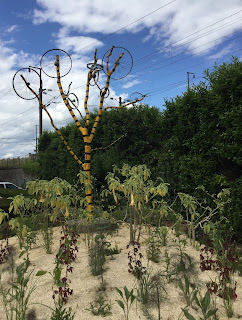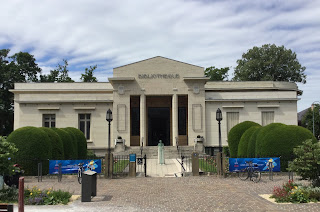One is never far from some historic site in France nor far either from a site with some cycling significance. Halfway between Nancy and Épernay, the Ville Arrivées for the third and fourth stages of The Tour, Bar-le-Duc offered up a magnificent monument from 1894 to honor Pierre and Ernest Michaux, the father and son blacksmiths who in 1861 had the stroke of genius to add pedals to the two-wheeled draisienne, the forerunner of the bicycle, elevating it to a viable means of transport. The pedals attached to the front wheel allowed one to generate much more speed than the scooter-effect of simply pushing one’s self along.
Pierre was born in Bar-le-Duc in 1813. There is a plaque on the home of his birth up a steep hill half a mile from his monument in the center of the town. He moved to Paris as a teen and worked on carriages until he created that miracle machine that changed history and that everyone had to have. He established the first bicycle factory employing 300 workers. They produced 200 of velocipedes a day. The tourist office in Bar-le-Duc had a replica of his invention.
Many of the towns along The Tour route already had mounted painted bikes and arrangements of wheels that would be the envy of any sculptor or florist. Every year residents along The Tour route affirm once again that there are no bounds of creativity when it comes to expressing one’s affection for the bicycle and The Tour.
The affluent wine-town Épernay, the stage three Ville Arrivée, the first in France after one and two in Belgium, allocated funds for an array of dazzling decorations. Among them were fifteen eye-catching photos along the sidewalk in front of its City Hall of seminal events in Tour lore—Coppi on L’Alpe d’Huez in 1952 (its first inclusion in The Tour), Thevenet on Pra Loup in 1975 defeating the seemingly unconquerable Merckx, Ocaña’s crash in the Pyrenees in 1971, Anquetil and Poulidor sharing a podium and others of Bobet, Hinault, LeMond, Indurain, Thomas, Evans, and Voeckler in Yellow. Passersby couldn’t help but stop and gaze upon these storied figures in the heat of action.
The peloton will be flying past them on their way to the finish a mile away up a steep final climb that will thwart the sprinters. Posts along the route had been wrapped in the colors emblematic of The Tour. A roundabout where the riders will make a hard right before their ascent was adorned with a giant wicker basket that had a band of yellow wheels around it, the first stunningly original creation I’ve come upon this year.
A steep climb of over a mile in the otherwise flat terrain separated Épernay from Reims, the next Ville Étape fifteen miles away. Reims, like Nancy, is among the larger cities in France with a population of nearly 200,000. It has such a varied and vital array of happenings it had nothing on display as of yet Tour-related. The city is always bustling with tourists attracted by its spectacular World Heritage cathedral where for centuries the French kings were crowned. A statue of Joan of Arc faces it, as she came to Reims in 1429 to tell Charles VII that the voice of God had instructed her to lead French forces to repel the English.
Just a couple blocks from the cathedral is the lone Carnegie Library in France, erected after WWI to replace the one that had been destroyed during the war. A bust of Carnegie stands in the walkway to its entry. I spent an hour sitting at a desk reading until the library closed at one for lunch.
Reims is one of the nine cities in France hosting matches in the women’s World Cup that just started. A few clusters of fans waving their country’s flags added to the ambiance of this most pleasant of cities.










2 comments:
George did you drop in to the Reims tourist office to see if the rude guy is still employed there?
He’s long gone and the tourist office has a new location with a gift shop that one must walk through. It’s still right there by the cathedral though. That guy was a classic though.
Post a Comment